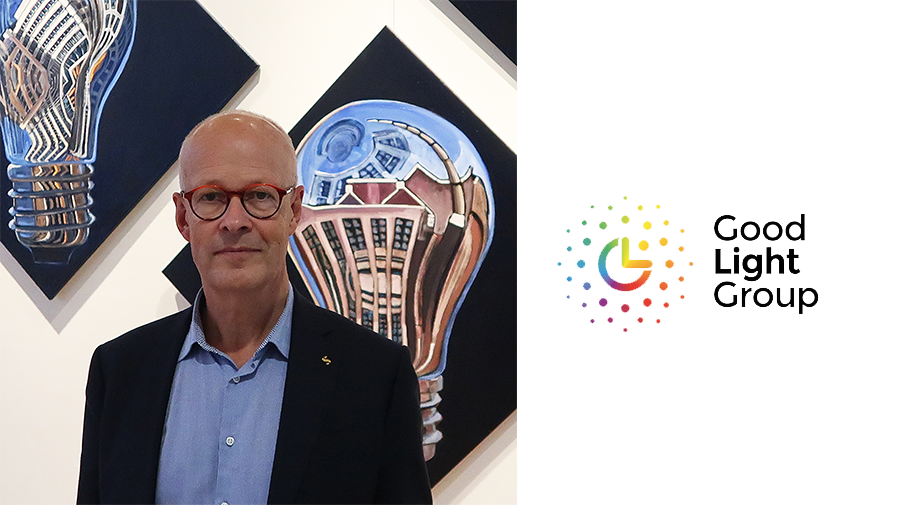
Jan Denneman is the Chairman of the Board of The Good Light Group, a global non-profit organisation promoting the benefits of light on the body and brain.
Jan founded the group after a career of over 40 years in the lighting industry, notably as the Vice President at Philips Lighting/Signify.
As a new participant of the group, LYS had the pleasure of speaking to Jan about his life, work and inspiration.
Why did you start the Good Light Group? What’s the mission of the organisation?
We founded the group based on the philosophy that 5 billion people live and work in ‘biological darkness’. That’s how we describe light that might be good enough to see, but isn’t good enough to support your biological clock.
For over 20 years, researchers have been warning about the risks of poor lighting and promoting the health benefits of good light. But it still feels like nobody knows!
Our main objective of the group is to stimulate the use of Good Light indoors. We want to bring universities, organisations and industry together to form a stronger force to help get this message across.
We started a year ago on the 16th of May, the International Day of Light. Since then, we’ve partnered with all kinds of organisations to help spread the message together — universities, lighting designers, lighting brands, architects and now LYS too!
How did you personally first become interested in the non-visual effects of light? What led you to found the group?
About 20 years ago at Philips Lighting (now Signify), we first started to hear about the new science emerging around light and circadian rhythms. As my career progressed, I became responsible for R&D. That’s when we really started to talk about ‘human-centric lighting’.
By the time I retired, I still felt the industry hadn’t communicated the huge health benefits of better lighting. I would go to conferences filled with scientists, designers and lighting professionals and we’d all be enthusiastically talking about revolutionising the lighting world. But word never got out of the room.
So when I retired from Philips after 42 years of service, I decided that we need to try another approach.
We need a collaborative, independent effort. We need to come together with all involved stakeholders to form a force loud enough to shout about the huge benefits for society and the wellbeing of people.
Are you seeing progress?
Yes, I think knowledge is growing. But people are still sitting in the dark.
More people know about light’s impact on our health, but the attention given to circadian lighting doesn’t measure up to its potential benefits.
Ultimately, lighting is still predominantly bought and sold on the idea of ‘buy-back time’. People think: ‘If I buy this solution how much money will I save in the short term?’
In my opinion, the costs associated with Good Light are insignificant when compared to what we have to gain.
Businesses, architects and designers have accepted the need to spend a little more on other environmental factors that impact our health. Unfortunately for the many people who live and work in poorly lit spaces, light still seems to get left off the list.
Why do you think the impact of light on our health and wellbeing gets overlooked?
I think the effects of light are slower and less immediate.
Ask someone ‘what makes a building healthy?’ The most common answers will be air quality, acoustics, temperature, and maybe access to green space.
That’s because you notice these factors straight away. When you walk into a room that’s too cold, for example, you know the environment’s not right. You feel uncomfortable right then and there.
With light, however, the effect is more subtle. It’s not as easy to recognise that poor lighting makes you tired at work, disrupts your sleep, and affects your mood.
These effects of light are slower, they build over time, but they’re no less damaging. Poor lighting causes everything from obesity, to depression and sleep disruption.
What’s the solution? Is the answer new products or do we need to change our behaviour?
I think we need both.
The easiest answer might be to spend more time outdoors. Realistically, however, the demands of our everyday life and work mean it has to be partly solved with new lighting products which provide Good Light indoors.
We also need more research and data. Although we absolutely know that light affects our sleep quality, well-being and health, the current research is still quite fragmented and small scale. Specifically, the guidelines for Good Light which attractive for the users indoors need development.
It’s why we want researchers and interior designers to join the Good Light Group too. We think that if society calls for good light, then the large scale research projects will follow.
What do you think the buildings and the lighting of the future will look like?
The world is in the midst of a huge crisis. The way we work, travel and live has been turned upside down by coronavirus.
In the Netherlands, a lot of people are talking about ‘the new normal’. As we enter this new phase, there’s a growing feeling that we have an opportunity to change for the better.
I hope that we will finally start to create spaces that suit the biology of people.
I think people will start to realise that Good Light is a cheap and easy way to improve people’s health. The effort is more than worth the benefits to our individual wellbeing and society as a whole.
To find out more about The Good Light Group, visit www.goodlightgroup.org